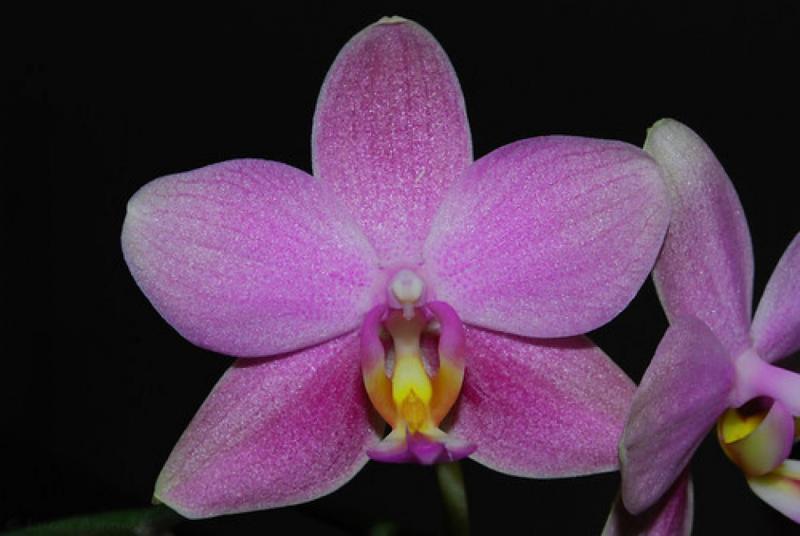Phalaenopsis sanderiana
Also known as: Sander's Phalaenopsis or Phalaenopsis sanderiana var. marmorata Phalaenopsis sanderiana subvar. alba Phalaenopsis sanderiana var. pulcherrima Phalaenopsis sanderiana subvar. marmorata Phalaenopsis sanderiana var. punctata Phalaenopsis amabilis subvar. sanderiana Phalaenopsis amabilis var. sanderiana Phalaenopsis sanderiana subvar. punctata Phalaenopsis sanderana Phalaenopsis amabilis f. alba Phalaenopsis amabilis f. marmorata Phalaenopsis aphrodite var. sanderiana Phalaenopsis sanderiana var. alba Phalaenopsis amabilis f. punctata Phalaenopsis sanderiana f. alba Phalaenopsis alcicornis in the subfamily: Epidendroideae
Native to: Philippines
General Information
Sander's Phalaenopsis is a monopodial warm to hot growing epiphytic orchid belonging to the sub family Epidendroideae native to Philippines. It is named after the English Orchid Grower in the 19th century.
Plant Description
Monopodial. Each new growth has numerous thick elliptic, oblong shaped leaves that grow to 25cm long
Substrate(s)
- Bark
- Charcoal
- Spaghnum Moss
- Perlite
- Sand
Care Notes
These orchids live in environments that receive constant moisture, high humidity, and are surrounded by other plants such as ferns and mosses which not only attract moisture but compete for it as well.
As a consequence they can be difficult to keep healthy in an artificial environment where a constant balance has to be maintained between providing constant moisture to the roots, but also allowing them to not become soggy and dry quickly as they would in the wild. For this reason it's important to take into account the size of the plant, the health and fragility of the root system, and also think about your watering habits. If you water frequently you can use a media that drains more freely, if you water less reliably you will need to find a media that offers retention and keeps humidity around the roots without being soggy.
Because these orchids like high amounts of water, other plants such as ferns and weeds may start to grow alongside the orchid, whose roots can make the media quite dense, effectively strangling the orchid's roots, it's best to pluck them out before they become a problem. Fungus and bacteria can be an issue as well, but usually are a sign of overwatering, smell the media occasionally to check, and increase airflow, reduce watering, and adjust temperatures accordingly (often bacteria only flourish in warmer temperatures, fungus less so).
Climate
Grows at low elevations. Rainfall ranges from 114mm to 234mm per day, heaviest in May and lightest in February. Humidity ranges from 78% to 84%, highest in July and lowest in March. Temperature ranges from 21C to 32C, highest in April (22C to 32C) and lowest in January (21C to 29C).
Watering
These orchids prefer a constant supply of moisture, with a slight drying out between waterings. Saucers can be placed under pots to retain moisture during hot weather, however the saucers should be removed or let to dry every 1-2 weeks to prevent rot. Keep an eye on the plant especially in hot weather and look for cues of under/overwatering and adjust accordingly.
Fertiliser
These orchids do not need to be regularly fertilised and roots may be sensitive to salt build-up, dying back and therefore impairing the plants growth or even killing it.
If fertilising, use half to quarter of the recommended amount of fertiliser. If they receive fertiliser as part of a collection, be sure to flush out the pots regularly with fresh water and monitor the roots by checking how much resistance is given by the plant when nudged in its pot or mount. If the plant becomes wobbly or loose, repot in fresh mix or rinse the media/mount thoroughly and do not fertilise for at least 3 months.
Apply fertiliser regularly at half strength year round.Potting
These plants are quite forgiving and will do well repotted ever 2-3 years. The mix should be coarse, well draining, and allow space for air to move and for roots to grow.
Alternatively, these plants will also do well mounted to tree fern or cork slabs, or mounted to trees.
Best time for repotting or mounting the orchids is the end of winter when new growths start to appear. Avoid repotting during hot weather,









